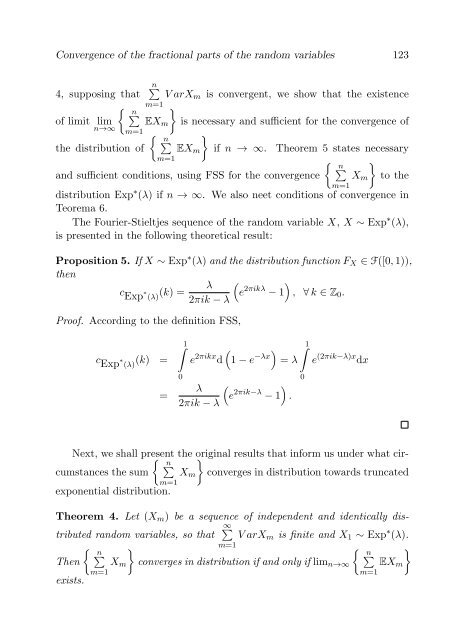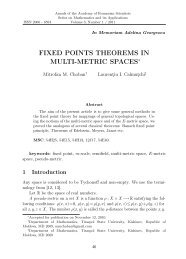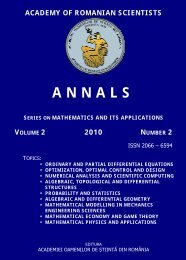convergence of the fractional parts of the random variables to the ...
convergence of the fractional parts of the random variables to the ...
convergence of the fractional parts of the random variables to the ...
You also want an ePaper? Increase the reach of your titles
YUMPU automatically turns print PDFs into web optimized ePapers that Google loves.
Convergence <strong>of</strong> <strong>the</strong> <strong>fractional</strong> <strong>parts</strong> <strong>of</strong> <strong>the</strong> <strong>random</strong> <strong>variables</strong> 123<br />
n∑<br />
4, supposing that V arX m is convergent, we show that <strong>the</strong> existence<br />
{ m=1<br />
n∑<br />
}<br />
<strong>of</strong> limit lim EX m is necessary and sufficient for <strong>the</strong> <strong>convergence</strong> <strong>of</strong><br />
n→∞ m=1 { n∑<br />
}<br />
<strong>the</strong> distribution <strong>of</strong> EX m if n → ∞. Theorem 5 states necessary<br />
m=1 { n∑<br />
}<br />
and sufficient conditions, using FSS for <strong>the</strong> <strong>convergence</strong> X m <strong>to</strong> <strong>the</strong><br />
m=1<br />
distribution Exp ∗ (λ) if n → ∞. We also neet conditions <strong>of</strong> <strong>convergence</strong> in<br />
Teorema 6.<br />
The Fourier-Stieltjes sequence <strong>of</strong> <strong>the</strong> <strong>random</strong> variable X, X ∼ Exp ∗ (λ),<br />
is presented in <strong>the</strong> following <strong>the</strong>oretical result:<br />
Proposition 5. If X ∼ Exp ∗ (λ) and <strong>the</strong> distribution function F X ∈ F([0, 1)),<br />
<strong>the</strong>n<br />
λ<br />
( )<br />
c Exp<br />
∗ (λ)<br />
(k) =<br />
e 2πikλ − 1 , ∀ k ∈ Z 0 .<br />
2πik − λ<br />
Pro<strong>of</strong>. According <strong>to</strong> <strong>the</strong> definition FSS,<br />
c Exp<br />
∗ (λ)<br />
(k) =<br />
=<br />
∫ 1<br />
0<br />
(<br />
e 2πikx d 1 − e −λx) ∫ 1<br />
= λ<br />
λ<br />
2πik − λ<br />
( )<br />
e 2πik−λ − 1 .<br />
0<br />
e (2πik−λ)x dx<br />
Next, we shall present { <strong>the</strong> original results that inform us under what circumstances<br />
<strong>the</strong> sum X m converges in distribution <strong>to</strong>wards truncated<br />
n∑<br />
}<br />
m=1<br />
exponential distribution.<br />
Theorem 4. Let (X m ) be a sequence <strong>of</strong> independent and identically distributed<br />
<strong>random</strong> <strong>variables</strong>, so that V arX m is finite and X 1 ∼ Exp ∗ (λ).<br />
∞∑<br />
{ m=1<br />
n∑<br />
}<br />
{ n∑<br />
}<br />
Then X m converges in distribution if and only if lim n→∞ EX m<br />
m=1 m=1<br />
exists.






